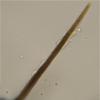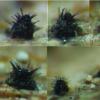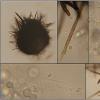
21-12-2025 09:32
Hello.A tiny ascomycete found embedded in wood in

21-12-2025 21:32
Pol DebaenstHello, Garden, Burgweg 19, Veurne, BelgiumOn 10/1

22-12-2025 23:38
Patrice TANCHAUDBonsoir, récolte sur un mur en pierre, apothéci

22-12-2025 00:47
Patrice TANCHAUDBonsoir, récolte à proximité du milieu dunaire

21-12-2025 21:40
Isabelle CharissouBonjour, j'aimerais connaitre les références de

20-12-2025 23:08
Patrice TANCHAUDBonsoir, récolte sur sol sablonneux dans l'arri�
hairy ascomycet
Gernot Friebes,
04-06-2009 14:19
I try my luck again with this ascomycet. It grew on Picea, has beaked ostioles and is somehow semi-immersed, the ascomata are visibly hairy. The spores are 6,5-20,5 x 7-8 µm, brown, two-celled and verrucous, the asci are IKI-, 8-spored and unitunicat with a sometimes truncate apex. I did not see any paraphyses. The hairs are thick-walled, light to dark brown, up to 97 µm long and up to 4 µm wide. If any further informations are needed I will try my best to look them up.
Best wishes,
Gernot
whole ascomata:
Gernot Friebes,
04-06-2009 14:22
Jacques Fournier,
04-06-2009 14:55

Re:hairy ascomycet
Hi Gernot,
good! thanks to these new data we already can tell what it is not, it is a first step.
Small hairy superficial ascomata with unitunicate asci with a ring-like structure and two-celled ellipsoid ascospores are reminisecent of two possible families, Chaetosphaeriaceae and Nieslliaceae. Absence of associated anamorph and paraphyses, and pigmented ascospore do not match well Chaetosphaeria.
Some other genera in the family have pigmented ascospores but either 3-septate or striate or porate at both ends.
Niessliaceae might be considered, though pigmented ascospores are not typical. Genera are first distinguished based on morphology of setae. I will send you some literature on this family.
I hope someone will have better leads to propose.
Best wishes,
Jacques
good! thanks to these new data we already can tell what it is not, it is a first step.
Small hairy superficial ascomata with unitunicate asci with a ring-like structure and two-celled ellipsoid ascospores are reminisecent of two possible families, Chaetosphaeriaceae and Nieslliaceae. Absence of associated anamorph and paraphyses, and pigmented ascospore do not match well Chaetosphaeria.
Some other genera in the family have pigmented ascospores but either 3-septate or striate or porate at both ends.
Niessliaceae might be considered, though pigmented ascospores are not typical. Genera are first distinguished based on morphology of setae. I will send you some literature on this family.
I hope someone will have better leads to propose.
Best wishes,
Jacques
NC NC,
04-06-2009 15:47
Re:hairy ascomycet
Hi Jacques,
thanks a lot for the descriptions of the families and for telling me which characters fit or do not fit, that helps me a lot! And thank you for sending me the literature (it is a very nice paper) but unfortunately no genera seems to fit in with my finding.
By the way, I forgot a "1" at the measurement of the spores - "16,5-20,5" is right an not "6,5-20,5".
Best wishes,
Gernot
Her another picture of a seta:
thanks a lot for the descriptions of the families and for telling me which characters fit or do not fit, that helps me a lot! And thank you for sending me the literature (it is a very nice paper) but unfortunately no genera seems to fit in with my finding.
By the way, I forgot a "1" at the measurement of the spores - "16,5-20,5" is right an not "6,5-20,5".
Best wishes,
Gernot
Her another picture of a seta:
Gernot Friebes,
04-06-2009 15:54
Re:hairy ascomycet
Hi Jacques,
thanks a lot for your help and for telling me about the families. It helps a lot when you say which character do fit and which do not. And thank you for the literature (it is a great paper) but unfortunately no genera seems to fit in with my finding.
By the way, there is a mistake in the measurement of the spores: "16,5-20,5 x 7-8 µm" is correct, not "6,5-20,5 x 7-8 µm".
Best wishes,
Gernot
Another photo of a seta:
thanks a lot for your help and for telling me about the families. It helps a lot when you say which character do fit and which do not. And thank you for the literature (it is a great paper) but unfortunately no genera seems to fit in with my finding.
By the way, there is a mistake in the measurement of the spores: "16,5-20,5 x 7-8 µm" is correct, not "6,5-20,5 x 7-8 µm".
Best wishes,
Gernot
Another photo of a seta:
Gernot Friebes,
07-09-2009 23:26
Re:hairy ascomycet
Hello,
sorry for writing in this old thread but now that I have a stereomicroscope I made some new pictures with maybe new informations. I am not sure anymore whether or not the asci are unitunicate because in some perithezia they were very thickwalled. I am quite sure that there are paraphyses or paraphysoids between the asci which are hard to see because of all the asci and setae. The setae are up to 120 x 5 µm, the asci are up to 103-110 x 12-15 µm with a sometimes slightly pleurorhynch base.
The thickest asci were as thick as those asci which I show on the fotos and I assume they are bitunicate. Which possibilities would there be with bitunicate asci? In my literature I do not find any proper direction for my find.
Best wishes,
Gernot
sorry for writing in this old thread but now that I have a stereomicroscope I made some new pictures with maybe new informations. I am not sure anymore whether or not the asci are unitunicate because in some perithezia they were very thickwalled. I am quite sure that there are paraphyses or paraphysoids between the asci which are hard to see because of all the asci and setae. The setae are up to 120 x 5 µm, the asci are up to 103-110 x 12-15 µm with a sometimes slightly pleurorhynch base.
The thickest asci were as thick as those asci which I show on the fotos and I assume they are bitunicate. Which possibilities would there be with bitunicate asci? In my literature I do not find any proper direction for my find.
Best wishes,
Gernot



 8086.pdf
8086.pdf


